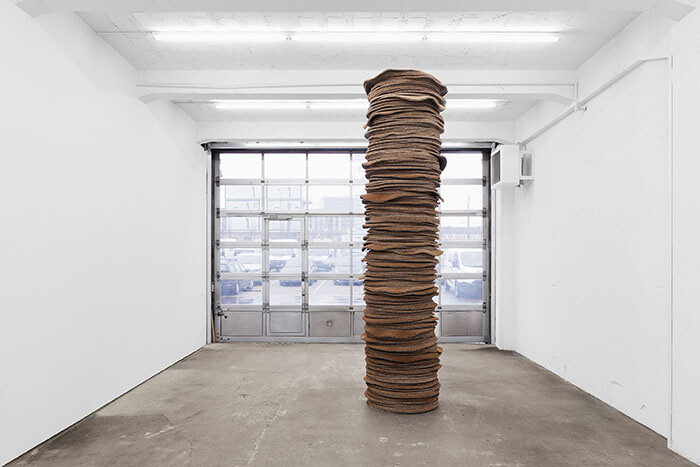The week before Kilian Rüthemann’s new exhibition opened at RaebervonStenglin in Zürich, a band of the great, good, wealthy, and hangers-on were in the luxurious Swiss mountain village of Gstaad for the launch of “Elevation 1049: Between Heaven and Hell,” an exhibition of works “positioned in and defined by the landscape they inhabit” that also runs until March 8th. Rüthemann’s contribution to the project is Acht Säulen für den Winter [Eight Columns for Winter] (2014), a row of eight palm tree trunks, upended and planted in the snow-covered lawn of the—indeed grand— hotel Le Grand Bellevue.
Back in Zürich, some three hours away, his solo show, “hatch up your troubles,” begins in a similar vein with One For Every Moment (Stack) (all works 2014), a rough, hairy column, which at four meters tall is just short of the ceiling in the gallery’s first room. Materially connected to the tree trunks shown in Gstaad, the column is made from a stack of coconut-fiber circular mats with rubber bases. Even though the work towers high, its layers look more like a sediment core drawn from the earth than a palm tree. The second work, hatch up your troubles, borrows its title from a 1949 Tom and Jerry cartoon that also names the exhibition; a small mouse hole cut into the wall dividing the gallery’s two rooms, it is much lower-key. The back gallery contains an Untitled sculpture made of a dull grey stack of wood cut into long, paper-thin sections, which lie in neat, taped bundles on top of a chock of paler-toned pine. With widths varying between 10 and 20 cm, the sections are completely aligned on one end and poke out in disorder on the other. It takes some time, and some insight from the gallery, to fathom exactly what the material is: an unearthed tree trunk, called bog oak, that has been preserved after lying for centuries, or maybe millennia, under damp, acidic peat.
This tree is a rare find, and exploiting its maximum industrial value today has meant rendering it as pure surface. Although bog oak would typically be rigid, the industrially processed version of it that Rüthemann uses—finely sliced into veneers for furniture and interior decoration—has become so flexible that it drapes over the supports beneath it, like a heavy blanket. In German, the word for “bog oak,” Mooreiche, is amusingly proximate to the other treasure found in the same environment, Moorleichen, or “bog corpses.” The unusual preservation of both is intriguing, and the wood is highly prized even though its consistency is often uneven. During the forty years Queen Victoria mourned Prince Albert’s death, for example, jewelry from jet-black bog oak was carved in the British Isles with great sophistication; the material has also been valued for making tobacco pipes. Its beautiful, somber, and powdery color can now lend spaces and objects the appearance, and yes, the veneer, of good taste, which brings to mind another German word, Kohle, or “coal,” often used as slang for money. Certainly, if you have enough of it, you can decorate your chalet with buried wood older than Jesus.
In the decidedly well-heeled town of Gstaad, criticality had as much chance of making an impression as a flea on the hide of an elephant. But closer to sea level in Zürich, Rüthemann’s works can be more pointed. Both social and physical connotations come to the fore in this trio of sculptures; the manner in which materials are gathered, processed, and presented becomes part of the final work, adding heft to physical forces like gravity. As has long been the case, Rüthemann engages with the inherent qualities of his materials—ranging from steel to foam, tar, concrete, plastic, glass, and sugar—and exploits the indelible marks preparatory industrial processes leave behind upon them. The memory these materials retain—and how they could revert to a former state when put under stress—has often introduced an extra frisson to his most powerful works. The mats from One for every moment (Stack), for example, were adulterated long before the artist bought them off the shelves at IKEA; composed of coconut fibers sown into a carpet of white silicone, they are hybrids of both natural and artificial materials.
Following the logic of the Tom and Jerry cartoon, solid forms can vaporize into thin air in the space of an instant: when Jerry inadvertently causes a woodpecker egg to hatch, the young, eager bird reduces everything it encounters to sawdust. However, within the gallery space, the mouse hole—located next to the indubitably solid, synthetic column and the prone tree, which should represent a swift, clean escape from danger—is a fiction. The gallery environment instead encourages the viewer not only to differentiate between materials, but also to reflect upon their material inequalities. Whether seemingly cored or dug up from the earth, scarce or readily available, these raw materials are indeed “authentic” and usually designed to decorate—or camouflage—our artificial environments. Thankfully, Rüthemann proposes entirely new outcomes for them.









